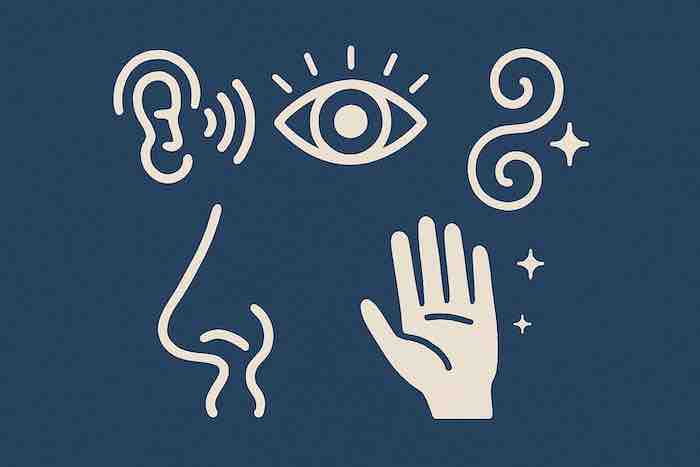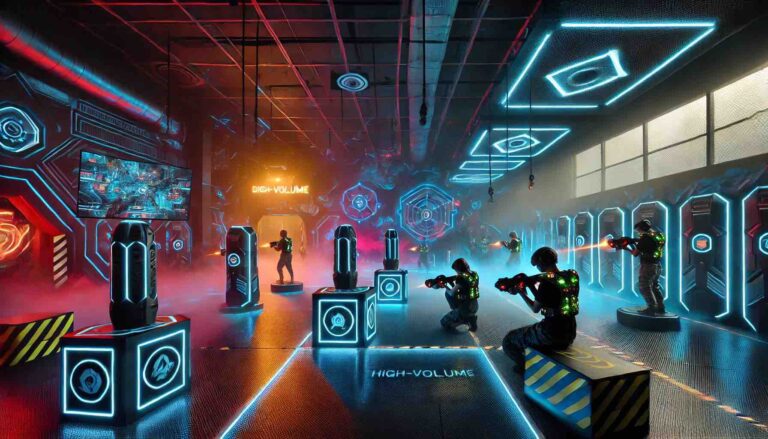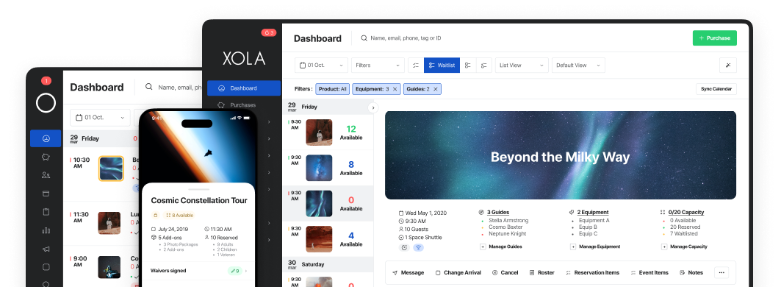
Whether you’re managing an escape room, a go-kart track, or an indoor trampoline park, having a solid marketing plan is your secret weapon to attracting new customers and turning them into loyal fans. Without a clear strategy, wasting time, money, and effort on tactics that don’t deliver is easy. In this post, we’ll dive into proven marketing approaches tailored for location-based businesses, with real-world examples you can apply to your attraction.
Define your marketing goals.
Before diving into your marketing efforts, let’s step back and define your goals. These are the pillars of every successful marketing campaign. Whether you run an escape room, go-kart facility, or another indoor experience, every location-based entertainment company focuses on building a strong brand presence in its community. Your goals might look like:
- Increasing Foot Traffic: Getting more customers through the door.
- Building Brand Awareness: Establishing yourself as a go-to entertainment in the area is crucial.
- Driving Repeat Visits: Building a loyal following.
- Leveraging Seasonal and Local Trends: Understanding the local market and capitalizing on trends, holidays, or events that drive interest (think school breaks and local festivals).
- Expanding Audience Reach: Reaching people beyond your community to increase those visitor numbers.
Let’s say you run an indoor trampoline park. Seasonal promotions — like a back-to-school deal with discounted entry for kids — are a great way to increase foot traffic. If you focus on driving repeat visits, a loyalty program where customers earn points for every visit (redeemable for free jump time or merchandise) can keep families coming back.
It’s about defining what you want to achieve first, ensuring your marketing strategy aligns with your vision for success.
OKRs vs. KPIs
Now let’s review the difference between OKRs (Objectives and Key Results) and KPIs (Key Performance Indicators), which measure your company’s marketing progress.
OKRs: Objectives and Key Results
OKRs are a goal-setting framework used to define and track your goals. The Objective is what you want to achieve, and the Key Results are the measurable results that tell you whether you’ve accomplished it.
Imagine you run a distillery tour with a goal of increasing annual visits by 20%. Here’s how you would apply OKRs:
- Objective: You want to boost visits to your distillery by 20% over the year, which is your big-picture goal.
- Key Results: These are the specific, measurable actions you’ll take to achieve that objective. You aim to increase website traffic by 10% through SEO and paid ads and launch a seasonal promotion that generates 500 new bookings in the next 3 months.
You can easily track your progress by defining your primary goal and breaking it down into quantitative actions. Each Key Result is a stepping stone that moves you closer to achieving that 20% growth in annual visits. If you reach or surpass your Key Results, you’ll know you’re on track to hit your big goal.
OKRs are great for setting clear, ambitious goals with a blueprint for your team to follow. They keep everyone aligned and working towards the same big-picture outcome. Plus, breaking down objectives into measurable key results allows you to track progress and celebrate wins as you go.
That said, OKRs can sometimes be too ambitious. This approach might lead you to take on goals that feel out of reach, which can be discouraging if you don’t meet them. OKRs also require regular check-ins to stay on track, which can be time-consuming for teams with a lot on their plates.
KPIs: Key Performance Indicators
KPIs are metrics that indicate how well your business is achieving its goals. Let’s say your goal is to increase direct bookings for your distillery tours. You would then track the following KPIs:
- Number of bookings per month made directly on your site
- Average spend per visitor on merchandise or tastings
- Conversion rate of website visitors to actual bookings
If the number of bookings increases or if the conversion rate improves, you know your marketing efforts are working.
KPIs are great because they offer clear and specific measurements for short-term performance. They allow you to adjust quickly and make data-driven decisions, keeping you and your team on the right track.
However, setting KPIs can also be limiting, like focusing too narrowly on specific metrics without considering the bigger picture and, for example, focusing too much on the number of bookings and ignoring customer satisfaction rates. Sure, your visitors will increase, but are they returning?
Know your customers
Understanding your customers is the backbone of every marketing strategy. You can tailor your marketing efforts to meet their needs when you genuinely know who your customers are, what they want, and why they choose your attraction over others. Let’s run through how to do effective customer research for your location-based entertainment business:
1. Survey Visitors
One of the easiest ways to gather feedback is through customer surveys. Create simple online surveys or send follow-up emails after guests leave. Ask what brought them in, what they enjoyed most, and what they think could be improved. You can also ask about demographics, like age and interests, to get a clearer picture of who’s coming in the door.
An axe-throwing venue could send a post-visit survey asking guests to rate their experience from 1 to 10. The survey will include questions about the booking process, satisfaction with the facilities, and whether they would recommend it to friends. This will help the operator understand what their guests liked, and what they would like to see improved.
2. Monitor Reviews
People love to share their experiences online. Stay on top of what your customers say in reviews, as that feedback can bring valuable insights into what they’re looking for in an experience. If you run a distillery tour and notice multiple reviews mentioning the lack of seating or poor signage, that’s a sign to address those issues.
3. Engage on Social Media
Social media isn’t just a marketing tool; it’s also a great place to listen to your customers. Monitor comments, direct messages, and hashtags to see what people say about your business. You can even start conversations with followers by asking questions or running polls. For instance, a go-kart track could use Instagram polls or Facebook posts asking followers what type of new race track design they’d love to try, gathering direct feedback from their audience.
4. Use Analytics Tools
Customer research isn’t just about asking questions—it’s also about reading the data. Use website and social media analytics to understand who’s interacting with your content. Tools like Google Analytics, Facebook Insights, and Instagram Analytics can break down visitor demographics, interests, and behaviors, providing valuable customer data.
For instance, if you run an indoor climbing gym and notice that younger people are visiting your website but not following through with bookings, you could adjust your website messaging with language that better appeals to that demographic.
5. Study Competitors
Look at your competitors to see who their customers are and how they’re engaging them. What types of promotions are they running? What are people saying about them? This can help you identify market gaps and determine how to differentiate your attraction from others around you. You’re one of three laser tag operators in your region. Research the other venues around you: Are they offering discounts for group bookings? If not, offering a similar deal could give you a competitive edge.
The 4 phases of a successful marketing plan for an LBE
We’ve covered the essential first steps—understanding your audience, setting clear goals with OKRs, and measuring success with KPIs. Let’s explore a specific approach that breaks down a marketing plan into four key phases. Think of a marketing plan like a funnel, with a top, middle, and bottom. Each phase serves a distinct purpose in guiding potential customers from awareness to loyalty. Let’s examine each phase and how they work together to drive results.
Attract: Top of the Funnel (TOFU)
At the top of the funnel (TOFU), your focus is on brand awareness. You want to get your brand in front of as many potential customers as possible. This phase is all about getting noticed, and you can accomplish that with:
- Social Media Ads: A trampoline park consistently posts photos of kids jumping, laughing, and having fun on social media. The operator promotes its back-to-school deal in the fall with a paid Instagram ad.
- SEO and Local Listings: Optimize your website for search engines so visitors can easily find you when searching for entertainment options in your city. List your business on Google My Business and review sites like Tripadvisor to boost your visibility.
- Influencer Partnerships: Partner with local influencers who align with your target audience. During an exciting game, a laser tag arena could team up with a popular local TikToker who streams the experience from their POV.
Convert: Middle of the Funnel (MOFU)
Once they’ve noticed you, the next step is to convert them into actual visitors. At this stage, the focus shifts from awareness to nurturing relationships and getting people to take action. Here’s how:
- Special Offers: Use limited-time offers like discounted tickets for new visitors or group deals. For example, a distillery tour could offer a “Buy One, Get One Half Off” deal to convert curious people who haven’t booked yet.
- Email Campaigns: Capture and nurture leads via email, highlighting upcoming events and seasonal deals. A mini golf course could create an email sequence targeting people interested but not booked. The emails could highlight a themed hole or new seasonal offerings, making them more likely to click through and reserve their spot.
- Remarketing Ads: Use remarketing strategies to promote the experience to people who have visited your website but haven’t made a booking.
Retain and Delight: Customer Satisfaction & Retention
Keeping existing customers happy is the most cost-effective way to grow your business. Here comes in retain and delight: The happier they are, the more likely they are to return. How to do it:
- Loyalty Programs: Reward repeat visitors, such as offering a free activity after a certain number of visits. A laser tag arena could offer a “Frequent Player” card, where guests earn a free game after attending 5 times.
- Engaging with Customers: Stay in touch with players via email or social media, sharing exclusive content and future promotions. A VR gaming center could send follow-up emails with exclusive invites to special events like a “VIP Gamer Night” or early access to new game releases, giving customers a reason to come back and try something new.
- Personalized Experiences: Provide tailored experiences or offers based on their past visits. For instance, a trampoline park could send personalized birthday offers for kids or special deals on group bookings for returning customers.
Analyze: Measuring Success and Doubling Down
The key to staying on track is to analyze your results regularly. If you ignore them, you’re just operating in the dark. Look at what’s driving traffic and conversions. Figure out what’s working so you can double down on it.
- Track Performance: Use analytics tools like Google Analytics, social media insights, and booking software reports to track key metrics like conversion rates, customer acquisition costs, and repeat visitor rates.
- Customer Feedback: Conduct customer surveys around specific areas of your campaign.
- Test and Optimize: Continually test different marketing tactics—new ads, email subject lines, or landing pages—and optimize based on what works.
***
In summary, a successful marketing plan for an LBE can be built around a simple framework: Attract, Convert, Retain & Delight, and Analyze. By following these phases, you’ll bring in new customers and keep them returning for more. The key is continuously measuring what works, adapting to your audience’s preferences, and ensuring every step of the journey, from awareness to repeat visits, is aligned with your target audience. With the right strategy, your location-based entertainment business will continue to rank among your area’s best things to do.




